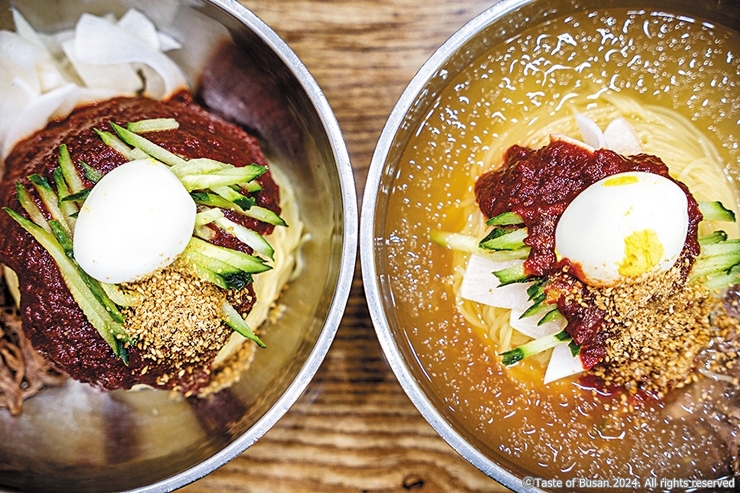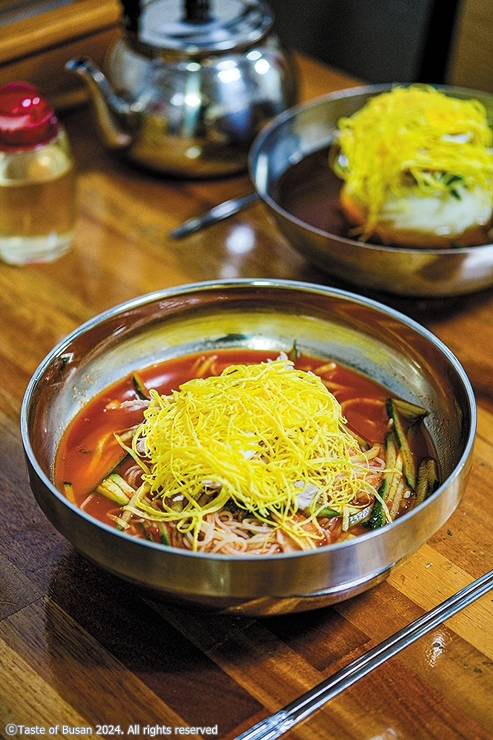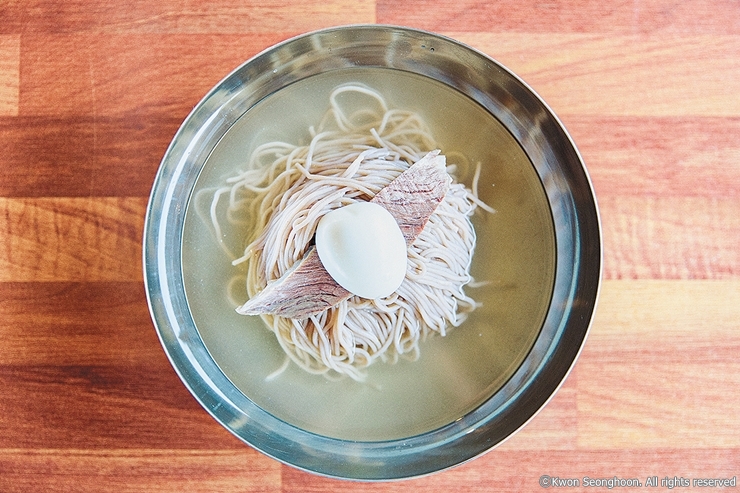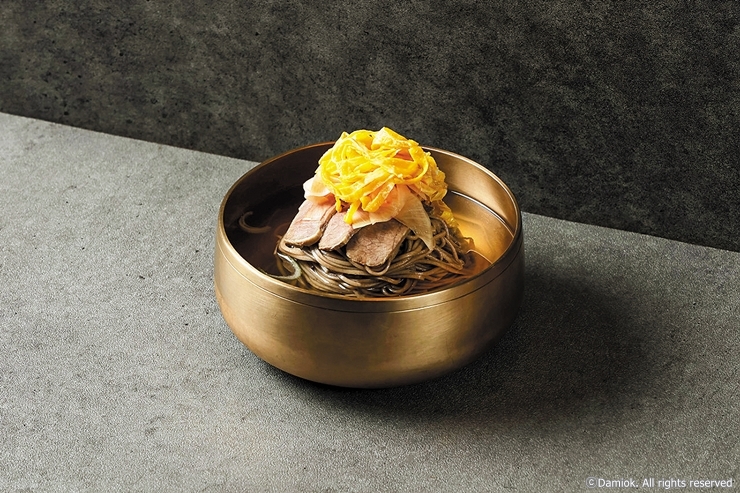Food
Naengmyeon beats the heat

Mul-milmyeon and bibim-milmyeon at Gukje Milmyeon.

Samsung milmyeon topped with thinly shredded fried eggs.
The mul-naengmyeon at Buda Myeonak.

The mul-naengmyeon at Damiok.
As we head into summer, Koreans' all-time favorite summer dish is in high demand. Typically served in deep and wide brass or stainless steel bowls, naengmyeon consists of a dense nest of noodles immersed in an ice-cold, savory, slightly sweet, tangy beef broth and topped with various proteins and vegetables.
Naengmyeon has been a staple in Korean cuisine for centuries. Cold noodles were a local specialty in the northern region dating back to the ancient state of Goryeo (918-1392). The expression "eating cold noodles in broth" is found in the collected literary works of Jang Yu, an important figure and scholar in the 16th century. Records from the Joseon Dynasty (1392-1897) show military officers rewarded with bowls of cold noodles after training.
During this long history, naengmyeon has evolved in various ways depending on the type of noodle and accompanying toppings. Broadly speaking, naengmyeon is categorized as "mul-naengmyeon," with noodles served in broth, or "bibim-naengmyeon," with noodles served covered in a sweet and spicy hot pepper paste.
However, regional styles may be an even more important distinction. Each region produces naengmyeon with distinct ingredients, textures and flavors. We will look at three: Pyongyang, Hamhung and Busan's "milmyeon."
Traditional naengmyeon traces back to two cities in North Korea: Pyongyang, the capital, and Hamhung.
Pyongyang naengmyeon is the standard and is considered the forefather of modern mul-naengmyeon. Since buckwheat was a staple crop in the region, this style uses buckwheat noodles served in "dongchimi" broth. Dongchimi is a type of "water kimchi" consisting of radishes, cabbage and other vegetables fermented in a sweet, tangy and refreshing brine.
The buckwheat noodles and dongchimi broth are typically garnished with pickled radish, slices of beef, julienned cucumber and half of a hard-boiled egg. For many, Pyongyang naengmyeon's subtle, even bland, taste is the Platonic ideal for a cold noodle dish.
Hamhung naengmyeon's signature noodles are made with starch flour, usually potato or sweet potato. The resulting noodles are thin, light-colored and very chewy. Typically, diners cut up the noodles to make them easier to eat. Hamhung naengmyeon is served with similar garnishes, but is traditionally enjoyed bibim-style. The chewy noodles covered in the sweet and spicy sauce are satisfying to a degree other dishes can't match.
Milmyeon was born when people from the north fled to Busan to escape the Korean War. These refugees brought their local cuisines to the city. However, the war made obtaining certain ingredients difficult. Buckwheat was plentiful in the north but scarce down south. However, wheat flour was widely available from the food aid provided by the U.S. military.
Thus, one of Busan's signature dishes was born. Keeping the basic outlines of the dish, the main difference between milmyeon and naengmyeon is the noodles. Milmyeon noodles consist primarily of wheat flour mixed with starch flour. The resulting noodles lie somewhere between the soft texture and nutty flavor of Pyeongyang-style noodles and thin, chewy Hamhung-style noodles.
To get a true taste of Busan, opt for "mul bibim-myeon," and get the best of both worlds. A bowl of tangled noodles, covered in sauce, topped with shredded cucumbers, thin slices of beef, half a hard-boiled egg, maybe a slice of pear and covered with an icy slush of beef broth is the perfect hot-weather meal.
■ Michelin Guide Picks
◎ Buda Myeonoak (Bib Gourmand selection)
Located near Haeundae Beach, this noodle haven offers Pyongyang cold buckwheat noodles made out of 100% buckwheat flour. The broth, made from Korean beef and mixed with vegetable broth, is savory, earthy and mild.
Address: 2F, 36 Jungdong 1-ro, Haeundae-gu
Hours: 11 a.m. to 7 p.m. Closed on Mondays.
Price: 12,000 won for naengmyeon.
◎ Damiok (Bib Gourmand selection)
Damiok specializes in Pyongyang-style cold buckwheat noodles that taste refreshingly light and clean. The pork, chicken and beef broth tastes pure and non-greasy. The noodles are housemade, and diners can select 100 percent buckwheat noodles, which have a pleasant, nutty flavor.
Address: 103, 15 Bokji-ro, Busanjin-gu
Hours: Open 11 a.m. to 8 p.m. from Tuesday to Saturday (break time from 3 to 5 p.m.). Open 11 a.m. to 3 p.m. on Sundays. Closed on Mondays.
Price: 12,000 won for naengmyeon. 12,000 won for buckwheat noodles with perilla oil.
■ Taste of Busan 2024 Picks
◎ Samseong Milmyeon
This milmyeon specialty restaurant has maintained its original taste for 60 years. It is also the only remaining milmyeon restaurant run by the first-generation owner. What more is there to say?
Address: 47 World Cup-daero 449beon-gil, Busanjin-gu
Hours: 10:30 a.m to 6 p.m. Closed on Tuesdays.
Price: 7,500 won for mul-milmyeon. 8,500 won for bibimyeon.
◎ Gukje Milmyeon
This place is widely recognized as one of the best spots for milmyeon, mainly for its exceptional taste. They present a distinct type of wheat noodles in beef bone broth. Elsewhere, the meat topping is usually cut by machines, but Gukje is known for hand-shredded, thin pieces of brisket.
Address: 23-6 Jungang-daero 1235beon-gil, Yeonje-gu
Hours: 10 a.m. to 9 p.m. from April to September, 10 a.m. to 8 p.m. from October to March. Closed on public holidays.
Price: 9,000 won for milmyeon.
<Vocab Spotlight>
brass: 황동
dense: 조밀한
immersed: 잠긴
tangy: 톡 쏘는
texture: (음식)식감
flavor: 풍미
buckwheat: 메밀
starch flour: 전분가루

